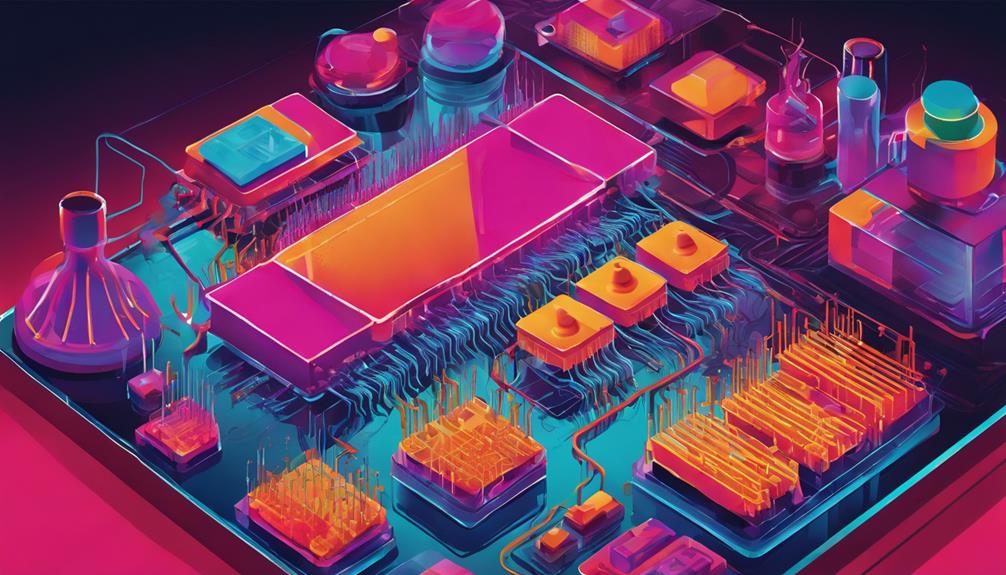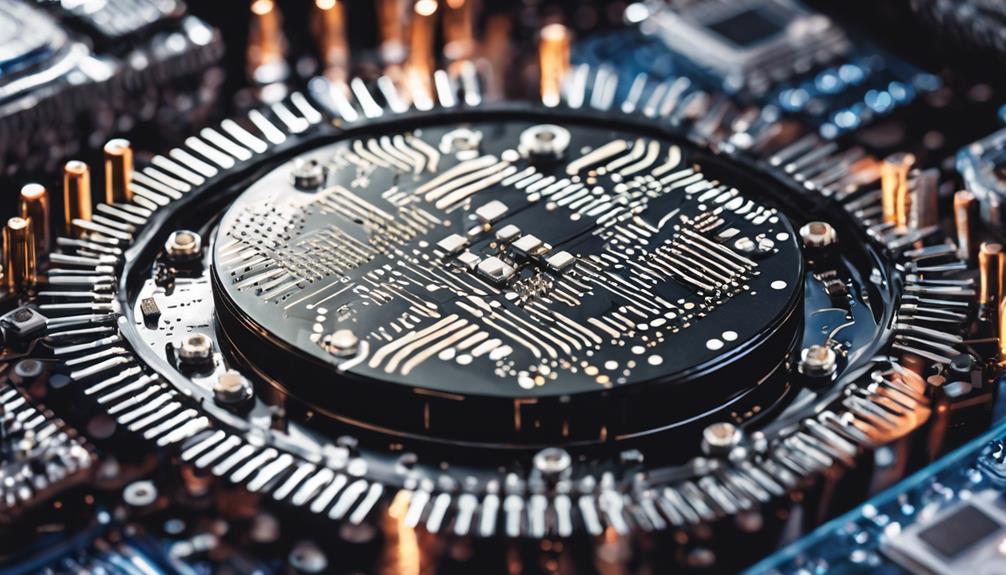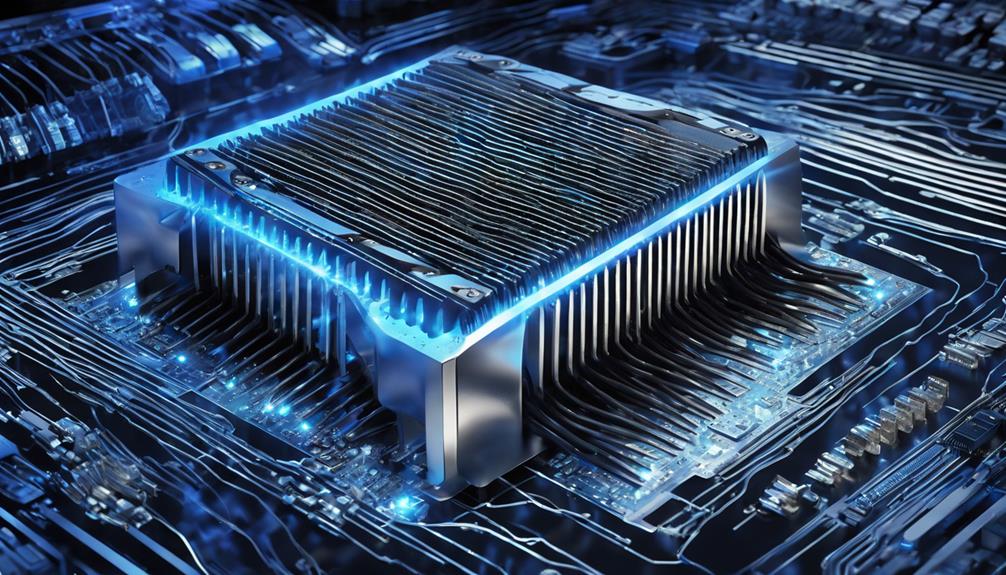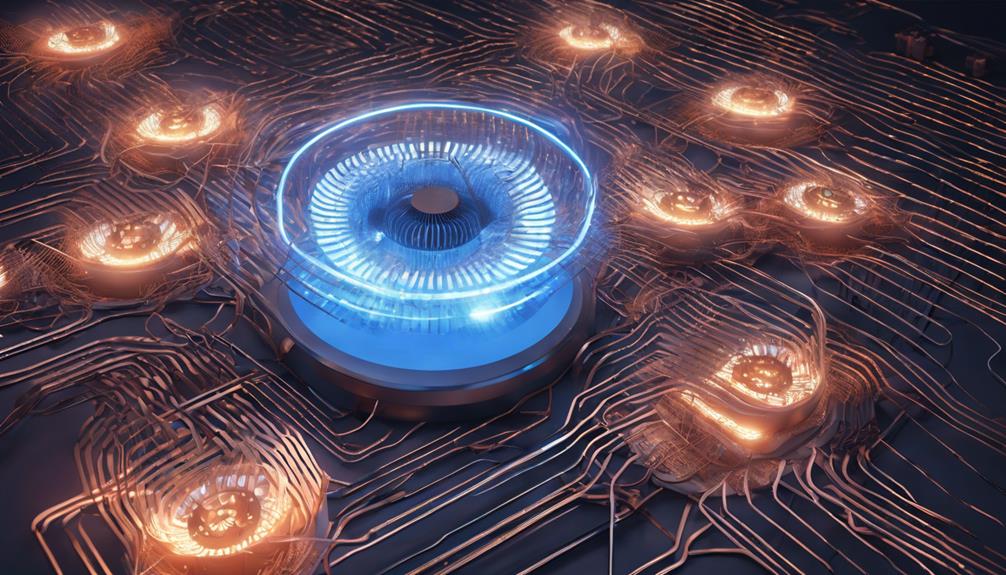For efficient assembly, selecting the right thermal interface material is essential for peak performance and heat dissipation. Adhesive tapes offer reliable heat dissipation and convenient component adhesion. Thermal pastes and greases provide high thermal conductivity and conform to irregular surfaces. Phase-change materials enable efficient heat transfer with low thermal impedance, while potting compounds and liquid adhesives offer excellent adhesion and thermal conductivity. Advanced materials provide unparalleled heat conduction capabilities for superior thermal management. These five thermal interface materials cater to diverse thermal management needs, and exploring their unique properties can lead to significant improvements in system performance and longevity.
Key Takeaways
- Adhesive tapes offer reliable heat dissipation and convenient component adhesion with strong bonds and effective thermal conductivity.
- Thermal pastes and greases provide high thermal conductivity and conform to irregular surfaces, with silicone-based greases offering excellent properties.
- Phase-change materials efficiently transfer heat with low thermal impedance and clean separation upon disassembly, eliminating cure cycles.
- Potting compounds and liquid adhesives ensure excellent adhesion, high thermal conductivity, and void-filling capabilities for enhanced reliability.
- Advanced materials with anisotropic properties and unparalleled heat conduction capabilities provide superior thermal management for optimal system performance.
Adhesive Tapes for Thermal Management
In the field of thermal management, adhesive tapes have emerged as a reliable solution for ensuring efficient heat dissipation in applications such as LED lights and semiconductor packages, where mechanical stability and cost-effectiveness are paramount.
These tapes offer a convenient and efficient way to adhere components while promoting proper heat dissipation, eliminating the need for additional mechanical attachments and simplifying the assembly process.
By providing a strong bond and effective thermal conductivity, adhesive tapes are commonly chosen for applications where reliable heat transfer is essential. As a result, they have become a popular choice for thermal interface materials (TIMs) in various electronic devices.
The use of adhesive tapes in thermal management helps guarantee reliable heat transfer and excellent performance of electronic devices, making them an essential component in modern electronics.
Thermal Pastes and Greases Explained

As the need for efficient thermal management continues to grow, thermal pastes and greases have emerged as reliable gap-fillers, designed to optimize heat transfer between components and heatsinks. These materials are specifically engineered to eliminate air gaps, ensuring effective heat transfer and minimizing thermal resistance.
Some key characteristics and benefits of thermal pastes and greases include:
- High thermal conductivity for efficient heat transfer
- Ability to conform to irregular surfaces, filling air gaps and ensuring ideal contact
- Manual or auto-dispensed application for precise control and uniform coverage
- Silicone-based greases offer excellent mechanical properties and flexibility
- No curing time required for greases, allowing for immediate application and assembly
Phase-Change Materials for Efficient Heat Transfer

Moreover, phase-change materials have emerged as a reliable solution for efficient heat transfer in electronic devices, thanks to their unique ability to change phase at specific temperatures. These materials offer precise heat transfer capabilities by changing from solid to liquid at specific temperatures, ensuring efficient heat dissipation in electronic devices.
Their low thermal impedance enables quick and reliable heat transfer, making them ideal for applications requiring consistent thermal management. Upon disassembly, phase-change materials provide clean and controlled separation, eliminating the need for frequent cleaning and maintenance. This feature is particularly beneficial for applications that require frequent maintenance, as it reduces downtime and increases overall efficiency.
Additionally, phase-change materials eliminate the need for cure cycles, making them convenient for quick and reliable assembly processes. By leveraging the benefits of phase-change materials, designers and engineers can achieve efficient heat transfer, reliable assembly, and reduced maintenance requirements.
Potting Compounds and Liquid Adhesives

Beyond phase-change materials, potting compounds and liquid adhesives emerge as specialized thermal interface materials, offering a distinct set of benefits for efficient heat transfer and protective encapsulation in electronic assemblies.
These materials are designed to fill voids, encapsulate components, and provide structural support in thermal management applications.
Key characteristics of potting compounds and liquid adhesives include:
- Excellent adhesion to various surfaces, ensuring secure attachment and effective heat dissipation
- High thermal conductivity properties to efficiently transfer heat away from sensitive components
- Ability to fill voids and encapsulate components, providing structural support and protection
- Enhanced reliability and longevity of electronic devices through proper selection and application
- Versatility in thermal management applications, including heat sinks, LEDs, and power electronics
Advanced Materials for Optimal Performance

Pyrolytic graphite-based advanced materials have emerged as a superior solution for ideal thermal management, offering unparalleled heat conduction capabilities and anisotropic properties that guarantee efficient heat dissipation in high-performance applications. These materials provide superior thermal management capabilities, ensuring ideal heat transfer and reducing thermal resistance.
By incorporating advanced materials in thermal interfaces, overall system performance and longevity are greatly enhanced. The exceptional thermal conductivity of pyrolytic graphite materials enables efficient heat transfer, making them an excellent choice for high-power devices. Advanced thermal interface materials are designed to reduce thermal resistance, ensuring efficient heat dissipation and preventing overheating.
This results in improved system performance, reliability, and longevity. By leveraging these advanced materials, manufacturers can develop high-performance systems that operate efficiently and reliably over an extended period. The integration of advanced materials in thermal interfaces is essential for achieving the best thermal management, ensuring efficient heat transfer, and reducing the risk of overheating.
Frequently Asked Questions
Can Thermal Interface Materials Be Reused After Disassembly?
The reusability of thermal interface materials (TIMs) after disassembly is an important consideration.
In general, most TIMs are designed for single-use applications and are not intended for reuse. The disassembly process can compromise the material's integrity, leading to reduced thermal performance and potential damage to adjacent components.
Reusing TIMs can also introduce contaminants, further degrading their effectiveness. As such, it is generally not recommended to reuse thermal interface materials after disassembly.
How Do I Ensure a Clean Surface for Thermal Interface Material Application?
To guarantee a clean surface for thermal interface material application, it is essential to follow a rigorous surface preparation protocol.
Begin by degreasing the surface using a solvent, followed by a gentle scrub with a soft-bristled brush to remove particulate contaminants.
Subsequently, wipe the surface with a lint-free cloth and inspect for any remaining impurities.
Are Thermal Interface Materials Compatible With All Electronic Components?
While the ideal scenario would be universal compatibility, thermal interface materials (TIMs) are not inherently compatible with all electronic components.
In reality, the suitability of a TIM depends on the specific component's material properties, operating conditions, and environmental factors.
For instance, certain TIMs may react with sensitive component materials or compromise their functionality.
Hence, it is important to carefully select and test TIMs for each specific application to guarantee reliable performance and prevent potential compatibility issues.
Can Thermal Interface Materials Be Mixed or Blended for Custom Properties?
Thermal interface materials can be mixed or blended to achieve custom properties, a process known as formulating. This involves combining different materials to tailor thermal conductivity, viscosity, and other characteristics to specific application requirements.
How Do I Store Thermal Interface Materials for Long-Term Shelf Life?
As a delicate flower requires nurturing to bloom, thermal interface materials demand careful storage to preserve their potency.
To guarantee long-term shelf life, store materials in a cool, dry environment (below 25°C and 60% relative humidity) away from direct sunlight. Use airtight containers or sealed bags to prevent moisture absorption, and label them with date and contents.
Regularly inspect stored materials for signs of degradation, ensuring peak performance when deployed.


